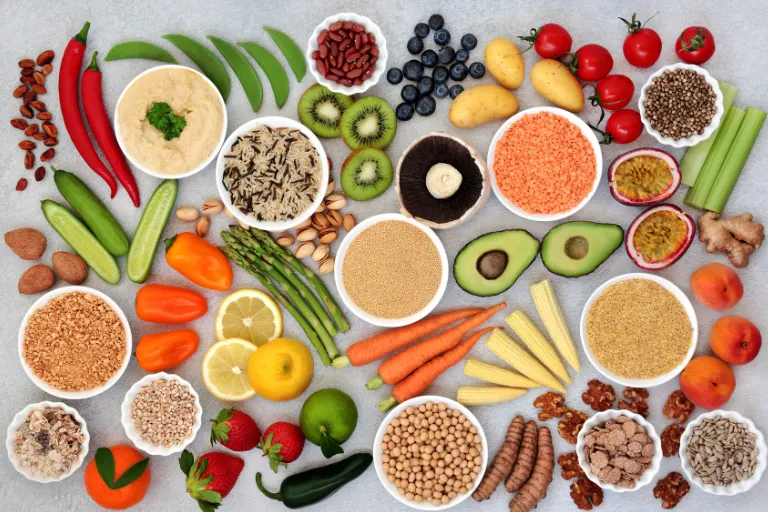Key Points
- Plant-based nutrition is accelerating in 2025, driven by health, environmental, and ethical priorities, with the global market projected to surpass $77 billion.
- Consumers are more label-conscious, focusing on microbiome health, regenerative agriculture, and clean, pronounceable ingredients.
- Scientific research confirms plant-based diets can support heart health, blood sugar regulation, and mood stability, while innovations like mycoprotein match animal proteins for muscle growth.
- Regenerative crops like lupin and fava beans are rising stars for their high protein, prebiotic fiber, and soil-enriching properties.
- Seaweed and algae are going mainstream, offering iodine, omega-3s, and antioxidants with potential brain and immune benefits.
- Precision-fermented fibers are being developed to boost gut-brain health and micronutrient delivery.
- New dairy alternatives (hemp, barley, potato milk) offer improved sustainability and nutrition over almond or oat milk.
- Upcycled foods are reducing waste while delivering nutrient-rich snacks and clean-label certifications that build consumer trust.
- AI-designed superfoods and 3D-printed meals are making personalized plant-based nutrition a reality.
- Culturally diverse plant staples like fonio, amaranth, and chaya are being reintroduced, highlighting culinary heritage and biodiversity.
- Practical advice includes eating 30+ plant varieties per week for microbiome health, checking fiber content, and prioritizing sustainable, fortified options.
In 2025, plant-based eating is no longer a fringe movement—it’s a full-blown cultural and scientific shift. From athletes chasing peak performance to Gen Z consumers demanding eco-conscious options, the appetite for plant-forward nutrition is booming. But with the rise of new ingredients, technologies, and global sourcing strategies, staying informed has never been more important.
Whether you’re a health professional counseling clients or a consumer simply trying to eat well and tread lightly, these are the plant-based nutrition trends reshaping what—and how—we eat this year.
Why It Matters: The Stakes Are Higher Than Ever
The global plant-based food market is projected to reach over $77 billion by 2025, reflecting rapid growth fueled by health, environmental, and ethical concerns1. But this isn’t just a trend—it’s a response to urgent public health, climate, and ethical challenges. Chronic symptoms like blood sugar regulation problems and joint pain are on the rise, while the food industry is under pressure to reduce emissions, conserve water, and offer transparency about sourcing and additives.
What’s at stake? Our physical health, planetary health, and even economic resilience. The good news is: innovation in plant-based nutrition isn’t slowing down—it’s accelerating.
Subscribe for Free for more insightful health articles tailored to your needs.
How It Shows Up: Consumer Shifts & Market Demands
Consumers are increasingly label-literate and mission-driven. A 2024 Mintel survey found that 68% of U.S. adults who consume plant-based foods do so to support digestive health, energy, and long-term wellness2. Millennials and Gen Z—digital-native and climate-aware—are driving demand for nutrient-rich, ethically sourced, and science-backed foods that support everything from mental balance to gut resilience.
But they’re not just asking, “Is this vegan?” They’re asking:
- Does this support my microbiome?
- Is it upcycled or regenerative?
- Can I pronounce the ingredients?
The Science: What We Know Now
Plant-based diets are increasingly recognized for supporting long-term health—especially in areas like heart health, blood sugar regulation, and mood stability. A growing body of evidence links fiber-rich, diverse plant diets to improved gut flora composition, reduced inflammation, and better regulation of the gut-brain axis3.
Meanwhile, emerging research is challenging old assumptions. A 2023 review in Nutrients found that plant proteins such as mycoprotein—derived from fungi—can match or even exceed animal protein in supporting muscle growth and post-workout recovery, thanks to their favorable amino acid profile and digestibility4.
Fermentation, precision agriculture, and AI-assisted formulation are also boosting the nutritional bioavailability of plant-based products—making 2025’s options not just ethical, but exceptionally effective.
The Top 7 Plant-Based Trends You’ll See Everywhere in 2025
1. Regenerative Ingredients Like Lupin and Fava Beans
Move over soy—less allergenic, nitrogen-fixing crops like lupin and fava beans are stepping into the spotlight. Rich in fiber, prebiotics, and protein, these legumes are also climate-resilient. Expect to see them in snack puffs, dairy alternatives, and high-protein flours.
Bonus: These crops improve soil health naturally by fixing nitrogen—supporting both planetary and human gut health5.
2. Seaweed and Algae Go Mainstream
Marine ingredients aren’t just for sushi anymore. High in iodine, omega-3s, and bioavailable minerals, seaweed and algae are now appearing in protein bars, plant-based burgers, and functional beverages. Spirulina and chlorella are increasingly combined with adaptogens to support mental balance and cellular recovery.
A 2023 paper in Frontiers in Nutrition highlighted the antioxidant and anti-inflammatory effects of algae-derived peptides, indicating strong potential for supporting immune and brain health6.
3. Fermented Fiber for Gut-Brain Balance
Fermented foods have long been staples of traditional diets—but in 2025, precision fermentation is transforming plant-based nutrition. This technique uses microbial cultures to produce or enhance nutrients like vitamin B12, omega-3s, and vegan proteins. Fermented fibers are particularly beneficial, helping generate short-chain fatty acids like butyrate that modulate mood and gut health simultaneously7.
4. Low-Impact Plant-Based Dairy 2.0
Almond and oat milk laid the groundwork—but they’re being joined by hemp, barley, pea, and even potato-based dairy alternatives. These new options are optimized for micronutrient density and reduced environmental impact, with many requiring significantly less water and land to produce[^8].
Look for fortified formulations that address common nutritional gaps, such as calcium, vitamin D, and magnesium—without compromising sustainability.
5. Upcycled Nutrition and Clean Labels
Waste reduction is nutrition’s new frontier. Upcycling fruit and vegetable peels, spent grains, and fiber-rich pulp into new snacks, powders, and flours is taking off. According to the Upcycled Food Association, demand for upcycled ingredients grew by over 120% in 2024 alone9.
Clean labels are also evolving—certifications like “Regenerative Organic Certified” and “Glyphosate Residue Free” are becoming standard on plant-based packaging, signaling a deeper consumer trust in food origin and processing.
Subscribe for Free for more insightful health articles tailored to your needs.
6. AI-Formulated Superfoods and 3D-Printed Meals
The future of food is smart. Companies are using AI to design customized meals based on a user’s nutrient deficiencies, gut microbiome, or even hormonal data. In Singapore and Sweden, early trials of 3D-printed plant-based meals—personalized for texture, flavor, and bioavailability—are already underway10.
This innovation promises a new level of personalization for dietary therapy and wellness.
7. Culturally Diverse Plant Staples Get Spotlighted
In 2025, the plant-based movement is going global—and local. Ancient crops like fonio, amaranth, teff, and chaya are gaining recognition for their resilience and nutrient density. These ingredients are being reintroduced into both fine dining and affordable packaged foods, spotlighting the culinary knowledge of Indigenous and diasporic communities11.
This trend reflects not just a culinary renaissance but a food justice movement—celebrating biodiversity and cultural heritage.
What This Means for You: Practical Steps Forward
- Consumers: Prioritize variety over perfection. Aim for 30+ plant types per week—a diversity threshold shown to benefit the gut microbiome12. Scan labels for fiber content, fermentation, and upcycled ingredients—not just protein.
- Wellness Professionals: Educate clients on plant protein quality and micronutrient sufficiency. Encourage fermented and fortified options to fill common nutritional gaps.
- Food Entrepreneurs: Develop products that serve dual roles—nutritionally functional and environmentally responsible. Transparency and storytelling are key in 2025.
- Retailers and Policy Makers: Prepare for a wave of consumer interest in clean labels, regenerative sourcing, and AI-guided personalization.
The Bottom Line
Plant-based eating in 2025 is about more than meat alternatives or almond milk. It’s about nutritional intelligence, ecological urgency, and a more inclusive definition of health. Whether it’s lupin in your pasta, spirulina in your latte, or AI in your food journal, the evolution is here—and it’s deeply rooted in both science and sustainability.
Further Reading:
- Nutrients journal on plant protein innovations
- Whole Foods’ 2025 food trend forecast
- EAT-Lancet Commission on planet-friendly diets
The article does not in any way constitute as medical advice. Please seek consultation with a licensed medical professional before starting any treatment. This website may receive commissions from the links or products mentioned in this article.
Subscribe for Free for more insightful health articles tailored to your needs.
Sources
- Bloomberg Intelligence, “Plant-Based Foods Poised for Explosive Growth,” 2023
- Mintel, “Plant-Based Food Trends and Consumer Insights,” 2024
- Sonnenburg, J.L. et al. “Gut Microbiota in Health and Disease,” Nature, 2023
- Derbyshire, E. “Mycoprotein as a Plant-Based Protein: Nutritional and Functional Perspectives,” Nutrients, 2023
- Regeneration International, “Climate Benefits of Nitrogen-Fixing Crops,” 2023
- Peñalver, R. et al., “Health Benefits of Algae Peptides,” Frontiers in Nutrition, 2023
- Silva, Y.P. et al., “Gut Microbiota-Fermented Fibers and Brain Health,” Nutrients, 2023
- Water Footprint Network, “Comparative Impact of Dairy Alternatives,” 2024
- Upcycled Food Association, “2024 Market Growth Report”
- Future Food Institute, “Personalized Nutrition and 3D Food Printing,” 2024
- Slow Food Foundation, “Traditional Crops and Culinary Diversity,” 2024
- American Gut Project, “Microbiome Diversity and Diet,” 2023




